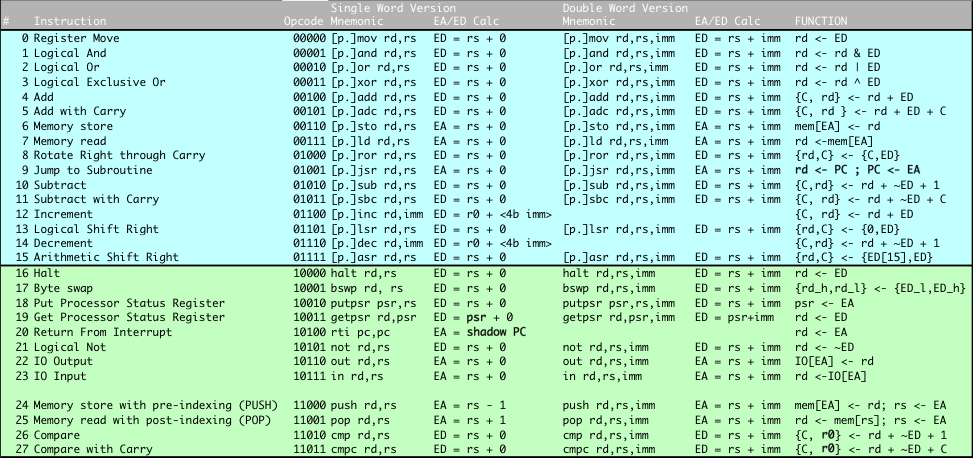opc
One Page CPU Project - CPU, Assembler & Emulator each in a single page of code
This project is maintained by revaldinho
OPC6 Definition
OPC-6 a pure 16 bit One Page Computer with a 16 entry register file based very largely on the earlier OPC-5 and OPC-5LS machines, but with a significantly extended instruction set.
All memory accesses are 16 bits wide and instructions are encoded in either one or two words ::
ppp l oooo ssss dddd nnnnnnnnnnnnnnnn
\ \ \ \ \ \_______ 16b optional operand word
\ \ \ \___\__________________ 4b source and destination registers
\ \___\__________________________ 1b instruction length + 4b opcode
\________________________________ 3b predicate bits
On reset the processor will start executing instructions from location 0.
OPC-6 has a 16 entry register file. Each instruction can specify one register as a source and another as both source and destination using the two 4 bit fields in the encoding. Two of the registers have special purposes:
- R0 holds ‘all-zeros’. It is legal to write R0 but this has no effect on the register contents.
- R15 is the program counter. This can be written or read like any other register.
Addressing Modes and Effective Address/Data Computation
The 16b effective address or data (EAD) for all instructions is created by adding the 16b operand to the source register. By using combinations of the zero register and zero operands with the LD and STO instructions the following addressing modes are supported:
| Mode | Source Reg | Operand | Effective address/Data |
|---|---|---|---|
| Direct | R0 | <addr> | mem[<addr>] |
| Indirect | <reg> | 0 | mem[<reg>] |
| Indexed | <reg> | <index> | mem[<reg> + <index>] |
| Immediate | R0 | <immed> | <immed> |
Processor Status Register
The processor has an 8 bit processor status register. Included in this arethree processor status flags which are set by ALU operations - calculation of the EAD values has no effect on these - and 5 bits related to interrupt handling.
- SWI - 4 bits used to identify a software interrupt. Writing a non-zero value here triggers a SWI.
- EI - used to enable or disable hardware interrupts
- Carry - set or cleared only on arithmetic operations
- Zero - set on every instruction based on the state of the destination register
- Sign - set when the MSB of the result is a ‘1’
Instruction Set

Notes:
- Where a [p.] is shown in the table, the instruction can be prefixed with a predicate (see table below) for conditional execution dependent on the state of the chosen flags
- All effective data/address calculations are truncated to 16bits and do not affect any of the processor flags
- add rd,rd can be used to synthesize an arithmetic shift left (asl) instruction
- adc rd,rd can be used to synthesize a rotate left through carry instruction
Predication
Many instructions can have predicated execution and this is determined by the three instruction MSBs and indicated by a prefix on the instruction mnemonic in the assembler.
| P0 | P1 | P2 | Asm Prefix | Function |
|---|---|---|---|---|
| 0 | 0 | 0 | 1. or none | Always execute |
| 0 | 0 | 1 | 0. | Used as a 5th opcode bit for extended instructions |
| 0 | 1 | 0 | z. | Execute if Zero flag is set |
| 0 | 1 | 1 | nz. | Execute if Zero flag is clear |
| 1 | 0 | 0 | c. | Execute if Carry flag is set |
| 1 | 0 | 1 | nc. | Execute if Carry flag is clear |
| 1 | 1 | 0 | mi. | Execute if Sign flag is set |
| 1 | 1 | 1 | pl. | Execute if Sign flag is clear |
Interrupts
OPC6 has two interrupt inputs for hardware interrupts: int_b[1:0].
If either of these inputs is taken low, then the processor with finish executing the current instruction and jump to a restart vector at either 0x0002 (for int_b[0]) or 0x0004 (for int_b[1]). If both interrupt pins are low at the same time then the processor will just to 0x0004 to service int_b[1] first.
Additionally there is an ability to cause software interrupts by writing a non-zero value to the SWI bits (see above) using the PUTPSR instruction. Software interrupts are also vectored to address 0x0002 in common with the hardware interrupt for int_b[0]. The interrupt service routine is responsible for reading to processor status register to determine the interrupt source.